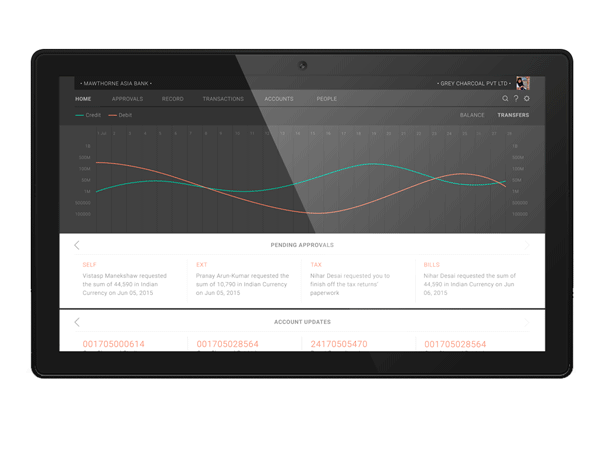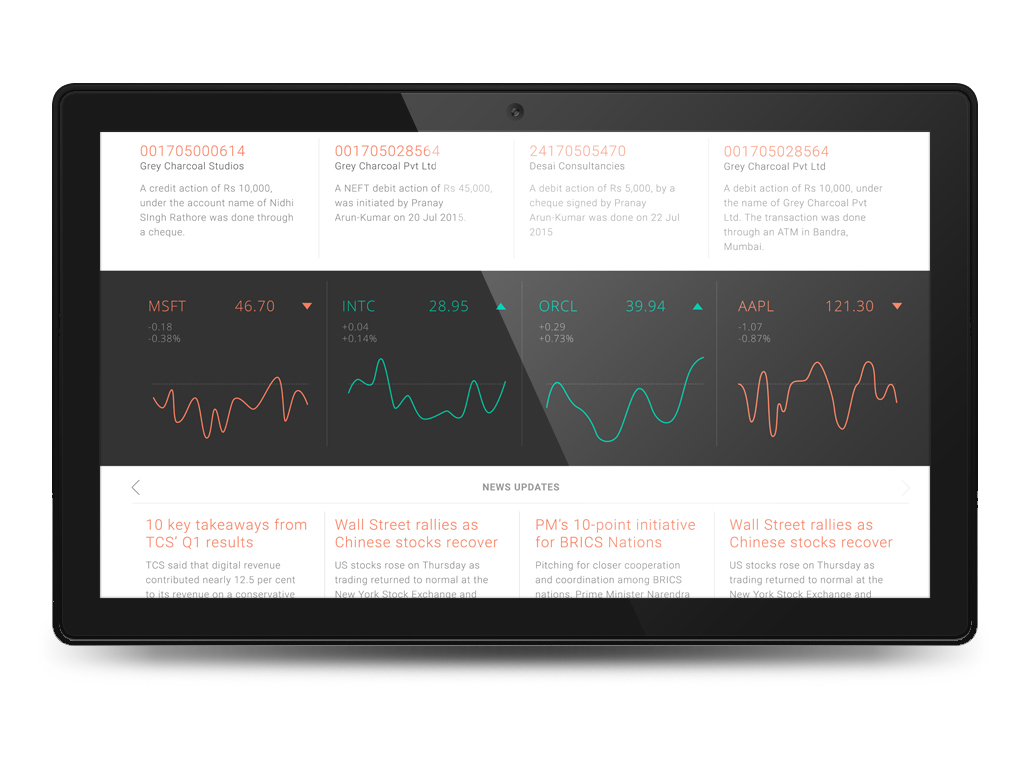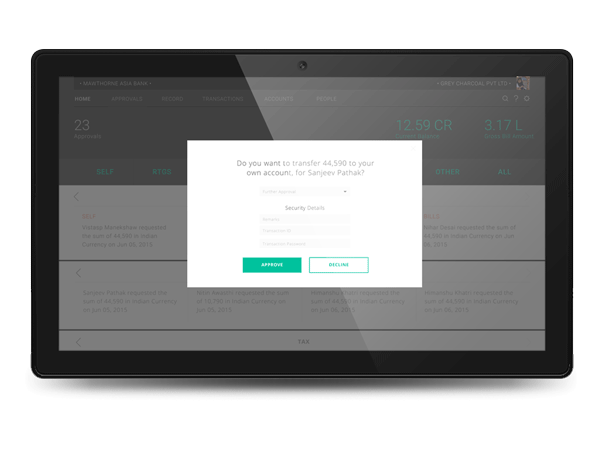
This project was to enhance the experience and involvement of the user with the application. The project aimed to be a redesign of User Interface. The cumulative design brief would be described as an attempt to improve the current corporate banking application, with increased services and visual simplicity. The client being one of the best in their field, they want to provide with new and better facilities and incentives to their users. Using applications to make your daily life effortless and interesting is not new to people, but using it to make big decisions and exhausting the medium is what we need.
This project was to provide the best one can get, from a banking applications. Client wanted to break rules and try to aim at a better future, where we save time, energy and resources.
Fig 1.a : BANKING BUSINESS MODEL: A bank can generate revenue in a variety of different ways including interest, transaction fees and financial advice. The main method is via charging interest on the capital it lends out to customers. The bank profits from the difference between the level of interest it pays for deposits and other sources of funds, and the level of interest it charges in its lending activities.
Fig 1.b: MOBILE BANKING MODEL: Mobile banking refers to provision and availability of banking and financial services with the help of mobile telecommunication devices. The scope of offered services may include facilities to conduct bank and stock market transactions, to administer accounts and to access customized information.
Most services in the category designated accounting and brokerage are transaction based. One deals with three interrelated concepts, which are Mobile Accounting, Mobile Financial Info Systems and Mobile Brokerage. There are plenty of services being provided by various banks and financial agencies, services which are other than dealing with account information.
The few challenges one can face while working on mobile application, which differs from one product to another and changes within the company as well. Few of them would be, handset operability, personalization, scalability, security, application distribution and reliability.


COMPETITION AND USERS
Generally it’s important to understand what your competitions are doing, so that the design you produce is better than the rest. But here it was really important to understand what they are doing it right, as it helps in comparing the problems and finding solutions for the same. Challengers are not just in the same domain, in this project they overlap with different types as it influences the lifestyle of primary audience.
The number of highest grossing applications are mostly in games, and that is because of the recreational values used by the same. As explained earlier, gamification helped a lot, but it’s also important to lure the user in the first impression.
Productivity apps were chosen purely because of the primary target audience, most of the applications in this are used by corporates or employees because it helps them sort out the information and work from wherever possible.
And lastly, social networking has become an integral part of the day-to-day life, as people share their thoughts, their activities and their plans. It doesn’t stop there, since it is widely spread it won’t be a surprise that most of the audience of such networking applications and sites would expect similar patterns.
Based on Dan Formosa’s research techniques, the focus was on distinct users, where two different types of scenarios were defined. Both types were a result of existing and prospective clients. The client not only serves a big group which is comparatively new, but also serves established empires which are more than 25-30 years old.
The first type is divided based on users and prospects, and deal with three options. Here it’s necessary to understand their problems and data weight, which after comparing turns out to be far apart from each other. The other type was based on the age of the firm, and few cases it might have overlapped with the age of the owner.
Fig 2.a : The user percentile divisions, Fig 2.b : Users divided based on the size of the firm, Fig 2.c : Users divided based on the age of the firm



CHAIN OF OPERATIONS
This application will be used by a varied audience, which ranges from proprietors to accountants of large corporations. The task flow in this case becomes integral because as the number of people increase, so do the issues of adaptability and flexibility. It’s also important to understand that the user will have to go through the same kind of information on a daily basis and the system should reduce mistakes and overlapping. The reason of less financial applications usage is because of the high level anxiousness, and hesitation due to large amount of money. This is one of biggest issues of these types of applications and it was one of the core points, which had to be addressed.
In a regular situation, an owner or accountant will send a request to another company or user, which in turn is received by the accounts team on the other end, Company B. It is necessary to understand the text and the request must be checked by the accountants in this case and then sent to the authorised signatory. They, then approve the same from their end, which may or may not be checked at this point. Then the request is taken to the RBI server, from where the money gets transferred and then the point A gets a notification of the same. In the scenario mentioned here, there are 4-5 different key points, depending on the number of authorised signatories one has, and size & type of the venture/ organisation. With such heavy duty surveillance, one needs to simplify the gestures and transitions and keep it minimal

DESIGN PROCESS
NID has its own way of design thinking and looking at problems from different perspectives. The process and outcome need to justify your dedication to the project. Especially in NID, process is given more attention and every single detail at the back end needs to be attended to. Students and designers in NID are encouraged to look for questions and then answer them with the help of the process. In this project the same attitude was represented, each and every detail gave birth to new questions and with a step further they were answered. The process was mainly dependent on the learning. The process was started from scratch and taken forward as questions arrived and solutions didn’t. The outcome was a result of a journey through various kinds of questions and finding their answers. The detailed process is based on every factor that affects the process of a design to come into being.

After reading and compiling the data, there were few things which needed attention immediately and the priority of the project happened to change over the period of time. Now it was not just an application redesign, since it was a banking application it was necessary to understand the anxiety spots of the user and fix them first. And the variety of clients added more complexity. We had to cater to each and every one, with the least number of communication problems. It was essential to understand how to use minimum input from the users’ side, and still provide a worthwhile experience. A banking product is generally dull and confuses users due to graphical and system errors, which the company finds difficult to solve each and every time. Through this project the small communication gap could be solved, and as one user mentioned, a good service is incentive enough.
Here are the rough workflow & flowchart of the application.


Initial wireframes for the application

A snapshot of the application's homepage


Profile Page of the User


Locator for bank branches and specific services

Transaction Approval Page

Different stages of the Transaction Approval



